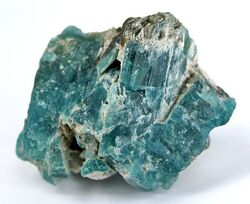Chemistry:Grandidierite
| Grandidierite | |
|---|---|
 Tabular crystals of grandidierite from the type locality in Madagascar | |
| General | |
| Category | Nesosilicate |
| Formula (repeating unit) | (Mg,Fe2+)Al3(BO3)(SiO4)O2 |
| Strunz classification | 9.AJ.05 |
| Dana classification | 54.01.01.01 |
| Crystal system | Orthorhombic |
| Crystal class | Dipyramidal H-M symbol: (2/m 2/m 2/m) |
| Space group | Pbnm |
| Identification | |
| Color | Cyan to turquoise; bluish green |
| Crystal habit | Tabular |
| Twinning | none |
| Cleavage | Good |
| Fracture | Brittle |
| Mohs scale hardness | 7.5 |
| |re|er}} | Vitreous, glassy |
| Streak | White |
| Diaphaneity | Transparent to translucent |
| Specific gravity | 2.85 to 3.00 |
| Density | 2.976 |
| Optical properties | Biaxial (-) |
| Refractive index | 1.583 – 1.639 |
| Pleochroism | Visible |
| 2V angle | Measured: 24° to 32°, calculated: 32° |
| Dispersion | strong r < v |
| References | [1][2][3] |
Grandidierite is a rare mineral that was first discovered in 1902 in southern Madagascar . The mineral was named in honor of French explorer Alfred Grandidier (1836–1912) who studied the natural history of Madagascar.[1]
Grandidierites appear bluer in color the more iron (Fe) they contain. A recently discovered gemstone, blue ominelite, is the Fe-analogue (Fe, Mg) to grandidierite (Mg, Fe).[5]
Grandidierites display strong trichroic pleochroism. That means that it can show three different colors depending on the viewing angle: dark blue-green, colorless (sometimes a very light yellow), or dark green.
While trichroism can usually help distinguish grandidierites from other gems, lazulites can occur with blue-green colors and show colorless/blue/dark blue pleochroism. Nevertheless, lazulites have somewhat higher refractive indices and specific gravity. Grandidierites also have greater hardness, with a 7.5 on the Mohs scale.
Large transparent faceted grandidierite specimens are extremely rare. The largest cut specimen currently known to the GIA weighs in at 763.5 carats.[6]
See also
References
- ↑ 1.0 1.1 Grandidierite: Grandidierite mineral information on Mindat
- ↑ Grandidierite mineral data on Webmineral
- ↑ Grandidierite on GemSociety
- ↑ Warr, L.N. (2021). "IMA–CNMNC approved mineral symbols". Mineralogical Magazine 85 (3): 291–320. doi:10.1180/mgm.2021.43. Bibcode: 2021MinM...85..291W.
- ↑ Ominelite on Mindat.org
- ↑ "Unusually Large Grandidierite | Gems & Gemology" (in en). https://www.gia.edu/gems-gemology/spring-2020-labnotes-unusually-large-grandidierite.
 |


